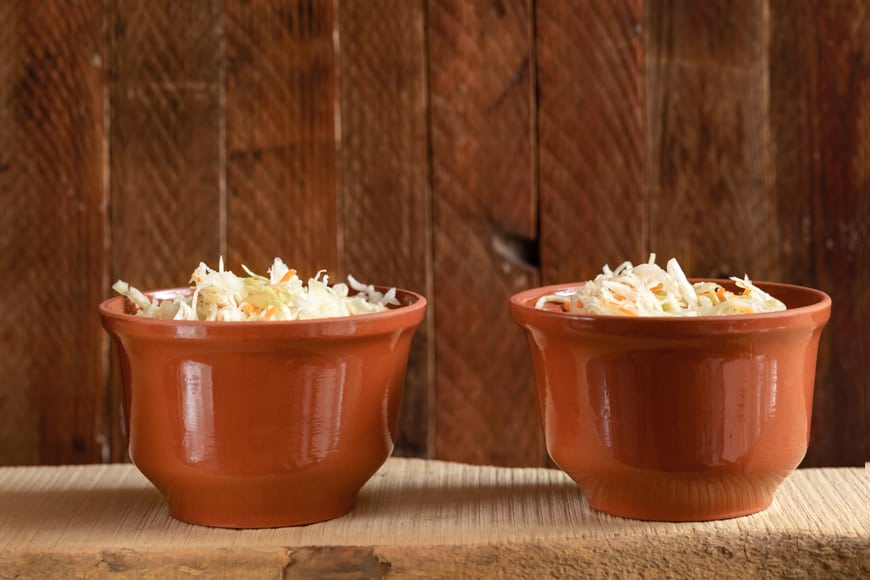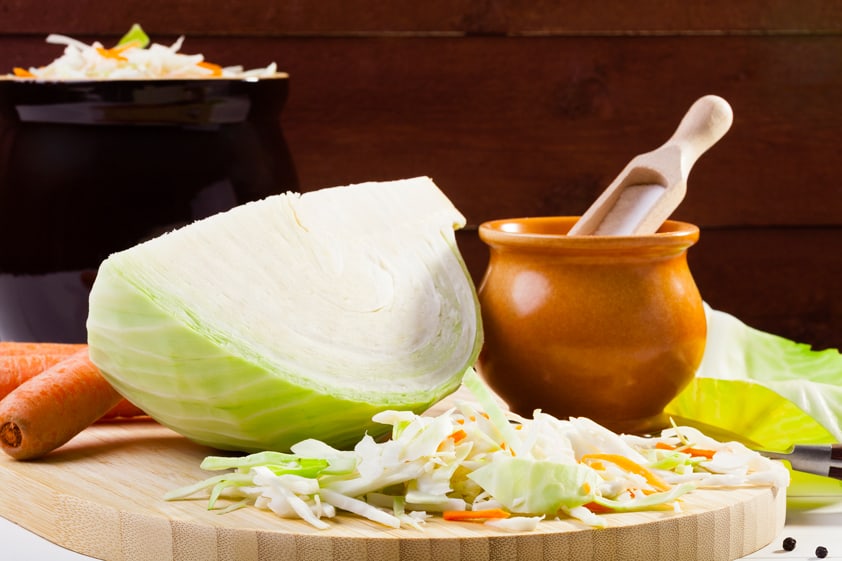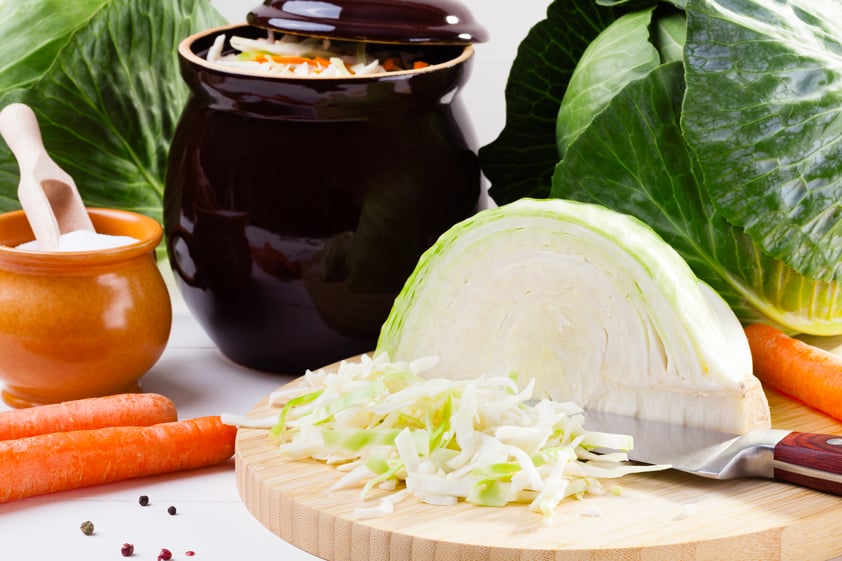![How to Make Sauerkraut in a Crock [Easy & Delicious Ferment]](https://myfermentedfoods.com/wp-content/uploads/2019/08/1-Depositphotos_355117354_ds.jpg)
If you are a serious fermenter and want to invest in the best fermenting equipment, I would suggest investing in a good fermenting vessel.
There are several options before you including mason jars, glass bottles, and crocks.
I love crocks.
The flavor of veggies fermented in crocks is heavenly, for the want of a better word.
If crocks are not your style, you can go in for glass or ceramic canning jars which come in a variety of sizes from a pint to gallons.
Whatever you choose, just avoid those plastic buckets since most cheap ones are full of BPA.
A crock is by far the best choice. You cannot beat a crock when it comes to comparing flavors of veggies fermented in it.
Even stainless steel metallic containers are not recommended for fermenting veggies since they end up reacting with the acids in fermented vegetables. So the best materials for fermenting are ceramic, glass, or wood (though not fir or other strong scented wood as their fragrance tends to easily transfer to the contents).
Today I will be discussing crocks and the easy steps to make sauerkraut in a crock.

If this is your first time fermenting…READ ON!
Before investing in a crock, which can be expensive, I’d recommend you try fermenting in No products found. first. Once you have learned the basics and can confidently ferment, then you can go right ahead and invest in a sauerkraut crock.
You can check out some of my other posts showing you how to make sauerkraut without making ‘newbie’ mistakes.
These resources will help you understand what it takes for fail-proof fermentation. You could start off by making a small batch of sauerkraut and see how you and your family like it. There is no point in making huge batches of fermented veggies in fermenting crocks if your family won’t touch it.
Fermentation is an art; it is also a science. Naturally, a million things can go wrong and a batch can spoil easily. I am not being negative here-just pragmatic. You probably won’t feel bad throwing a small jar of spoilt ferment, but a crock full of veggies? Now that is a different matter.
Worry not! My fool-proof sauerkraut in a crock recipe is easy and you cannot go wrong with it, provided you use the given steps correctly.
The key to getting any recipe right is following the steps. And once you do that, you are guaranteed success. Soon you will be fermenting like a pro and will be glad for having invested in a sauerkraut crock.
Sauerkraut Crocks
Traditional fermentation crocks are typically ceramic and dark brown though, these days, more vibrant colors are also available. They are ideal for making large batches of pickles and range in size from half a gallon to massive 5+ gallons.
Advantages of using crocks for sauerkraut fermentation
- Stability – Thick stoneware walls create a stable fermentation temperature.
- Better fermentation – A crock also allows greater range and distribution of beneficial bacteria to develop.
- No smell – you can make kimchi, sauerkraut, and other fermented veggies in your kitchen without worrying about smells during the fermentation process.
- Fast action – within 7-14 days, you will have delicious and healthy fermented foods available.
- Cheap health – Probiotic-rich fermented veggies are very good for digestive health. Salt, veggies, and a few spices are all you need to make them.
- No mold – Good quality crocks prevent undesirable mold or yeast formation. Sealed water top crocks (explained below) speed up fermentation without the formation of unfriendly microorganisms.
- Anaerobic fermentation – Well designed crocks allow gases to escape without letting in air, dust and harmful microbes to enter.
- Easy to clean – The wide mouth allows you to wipe down the crock before and after use.
- Weighted pressure – Some crocks come with weights (explained below) that help press down the veggies and encourage more liquid to be extracted due to the pressure.
Disadvantages of using crocks for fermentation over airlock jars
- The sealed environment makes it difficult to see what is going on inside.
- Expensive compared to fermenting jars or mason jars.
Types of fermentation crocks
Open crocks
In open fermenting crocks, the vegetables and brine are added and a plate is placed on top to hold whatever is being fermented under the brine.
A cloth is secured on the top over the opening. This is an easy way to ferment.
A disadvantage is that it develops mold on the surface and it can also get difficult to keep away fruit flies.
Water sealed crocks
Water sealed crocks are more sophisticated as they come with semi-circular weights to keep the ferment submerged.
The top edge of the jar has a moat or a long grove or channel that can be filled with water.
The lid is placed on this ‘moat’ which provides a seal and allows the gases formed during fermentation to pass out easily.
The water moat needs to be monitored and refilled when the water is lost to evaporation. This helps maintain a tight seal. The water also prevents air, harmful organisms, and dust from entering the pot.
Where to find good sauerkraut crocks?
Good quality crocks can cost a few hundred dollars depending on the brand and the size.
To save money on crocks, you can visit thrift stores, flea markets, estate sales, auctions, or garage sales to find good quality crocks.
I firmly believe in the saying: one man’s trash is another man’s treasure. You never know what you’d find. You might even get some grandma’s recipe book with the Crock when you visit someone’s yard sale.
Naturally, you may want to examine the used crock properly. Sometimes people sell or donate items because they have flaws. So watch out for crocks with cracks, leaks or defects. Steer clear of those.
When buying a new crock from the market, take some time to do your research. It is a good idea to find out if lead was used in its glaze.
Lead-free crocks are available in different sizes and from top brands like OHIO Stoneware, Harsch, Mortier Pilon, Humble House, TSM Products, K&K Keramik, Boleslawiec, and so on.
They come in 1, 2, 3, 4, 5, or 10-gallon sizes. Some of them do not include fermentation weights, so you need to make the weight using brine bags or by placing sterile ceramic dishes on top of the ferment. This is necessary to get adequate brine. And what is kraut without a lot of brine?
Why everyone loves German made sauerkraut crocks
German made sauerkraut crocks are known to be some of the best in the world. In particular, Harsch crocks named after the company that produced them, had a very strong strong following amongst fermenters. However, they were discontinued in 2013 (I’m not sure what the reason was) but can still be found on eBay or in second hand stores.
Today, K&K Keramik fermenting crocks by German company Kerazo are a popular choice offering the best value for the money.
They include stone weights to weigh down the veggies and help prevent spoilage.
The pressure also secretes more juices resulting in ferments with a lot of brine. Moreover, these crocks contain a water gutter or channel that allows the gases to escape all the while preventing external air from entering the pot.
A frequent concern which regular fermenters will be aware of is a certain kind of yeast that thrives on top of the ferment. This yeast is not harmful but it leads to off-flavors and needs to be skimmed off from time to time.
The thick sides of the crock make it very heavy and durable.
Instead of the weak handles of traditional crocks that tend to break off easily, K&K Keramik crocks come with sturdy carrying handles that cannot break (easily).
- Keramik German Made Fermenting Crock Pot is specially designed to ferment vegetables. Fermentation pot comes in a beautiful speckled earthen brown color with smooth and shiny finish.
- K&K Keramik Pot is FREE of Lead and Cadmium keeps the nutrition packed in sauerkraut and pickled vegetables. Keramic Pot is fired at 1260 C.
- High Quality Keramik Crock comes with Deep Gully that allows expelling of gas and prevents entry of outside air.
- Handles on both the sides of this Fermenting Pot, eases the transportation and lifting.
- Thick .6"(1.5 cms) base ensures Stability and walls are .4" makes it durable to use. Sauekraut Crock Pot 5 L from Kerazo comes with pot, lid, weighing stones and recipe book.
How to make sauerkraut in a crock
Now let’s make some sauerkraut in a crock. Here are the steps:
Step 1 – Gather your equipment
Apart from the crock, you will need some other equipment to make your fermented veggies.
Pickle weights
Based on the kind of crock you use, you would (or wouldn’t need these). Pickle weights are also called pickle pebbles. They are made with lead-free glass and designed to fit large mason jars or crockpots.
You can also use sterile glass plates (clean them in the dishwasher first), cabbage leaves, and brine bags to hold the ferment down.
Stompers or pounders
Vegetable pounders or stompers help extract liquid from the cabbage to create the brine.
You can always use your hands (wash them first!) to massage the salt in the cabbage.
Alternatively, add the shredded cabbage to the crock in layers and then stomp it with the pounders.
Choose stompers made with dense wood such as maple. Always wash and dry the stomper after use and before storing it away. You may also want to condition it from time to time using food-grade mineral oil to prevent drying and cracking.
Bowls
Use glass or BPA-free plastic bowls for salting, soaking and mixing your veggies. Glass is best since plastic could leach chemicals into the veggies and also attracts harmful bacteria and mold more than glass does.
Chopping boards
It is best to use wooden chopping boards, though, many people use plastic ones as they can be tossed in the dishwasher for cleaning.
No matter what product you use, wash and dry it well between uses.
Use separate boards for chopping vegetables and meat.
Thermometer
Since temperature is critical for proper fermentation, invest in a good No products found..
Sterilize it by rinsing it in boiling water and allow it to cool before taking a reading.
Step 2- Sterilize your equipment
- Inspect the jars for cracks and leaks.
- Before fermenting, sterilize your jars. This will prevent undesirable microbes from breeding and spoiling your ferment. Use hot soapy water to clean all equipment, jars, and crocks.
- Avoid using any sterilizing tablets or chemicals as these could taint the ferment and prevent beneficial bacteria from growing.
Step 3 – Gather your ingredients
You will need
- 20 lbs organic cabbage. Make sure the cabbage is organic. This is to ensure that no chemicals have touched it at any point from cultivation to harvesting to storage till the time it comes to your kitchen. Wash and dry them.
- 3 tbsp caraway seeds
- 50-70 juniper berries (optional). You can get these at specialty stores.
- 3 tbsp freshly chopped dill
- 10 tbsp or 120 grams of salt
Step 4 – Preparing the ingredients
- In a large bowl, combine all ingredients except the cabbage. Set aside.
- From a couple of cabbages, detach few large outer leaves. You will need these to weigh down the ferment. Ideally, the leaves need to form 1/8th inch layer on top. Wash, dry and save the leaves.
- Grate the rest of the cabbage.
Step 5 – Fill up the crock (assuming you use a crock with weights/stones)
- Place about 3 inches of grated cabbage at the bottom of the crock.
- Sprinkle in 2 tbsp of seasoning.
- Add another three inches of grated cabbage.
- Use a pounder on these layers to extract juices.
- Repeat the sequence to finish adding all the seasoning before adding the last and final layer of cabbage on top.
- Cover the top layer with cabbage leaves. (As stated before, this should be for a layer of about 1/8th inch thickness).
- Place the K&K Keramik stoneware or pickle pebbles on top.
- Push down until the stones are covered with at least ½ inch of brine juice.
- Place the K&K Keramik pot lid.
- Add water in the moat (water groove) to prevent the entry of air and harmful microbes in the pot.

Step 6 – Ferment (up to 2 weeks)
- Keep the pot at room temperature to encourage the fermentation process.
- Make sure you keep it above floor level to promote air circulation around the pot.
- Let it ferment, undisturbed for 2 weeks. Do not open the pot or move it.
- Make sure that the water groove is always filled with water.
Step 7 – Pack the kraut in smaller jars
- After two weeks, check the taste and smell of the ferment. The vegetables should be tart and crisp. If done right and you are satisfied with the taste, transfer small portions into smaller airtight glass containers. Make sure to leave some room on top before covering the lid.
- Sauerkraut can last for several months in the refrigerator.

Step 8 – Enjoy!
- Serve the kraut with your main meals. Kraut is a delicious accompaniment to sandwiches and wraps.
- Add the sauerkraut to soups, broths, and salads for enhancing their taste and boosting their benefits.· You can also check out some delicious recipes that contain sauerkraut.


Leave a Reply